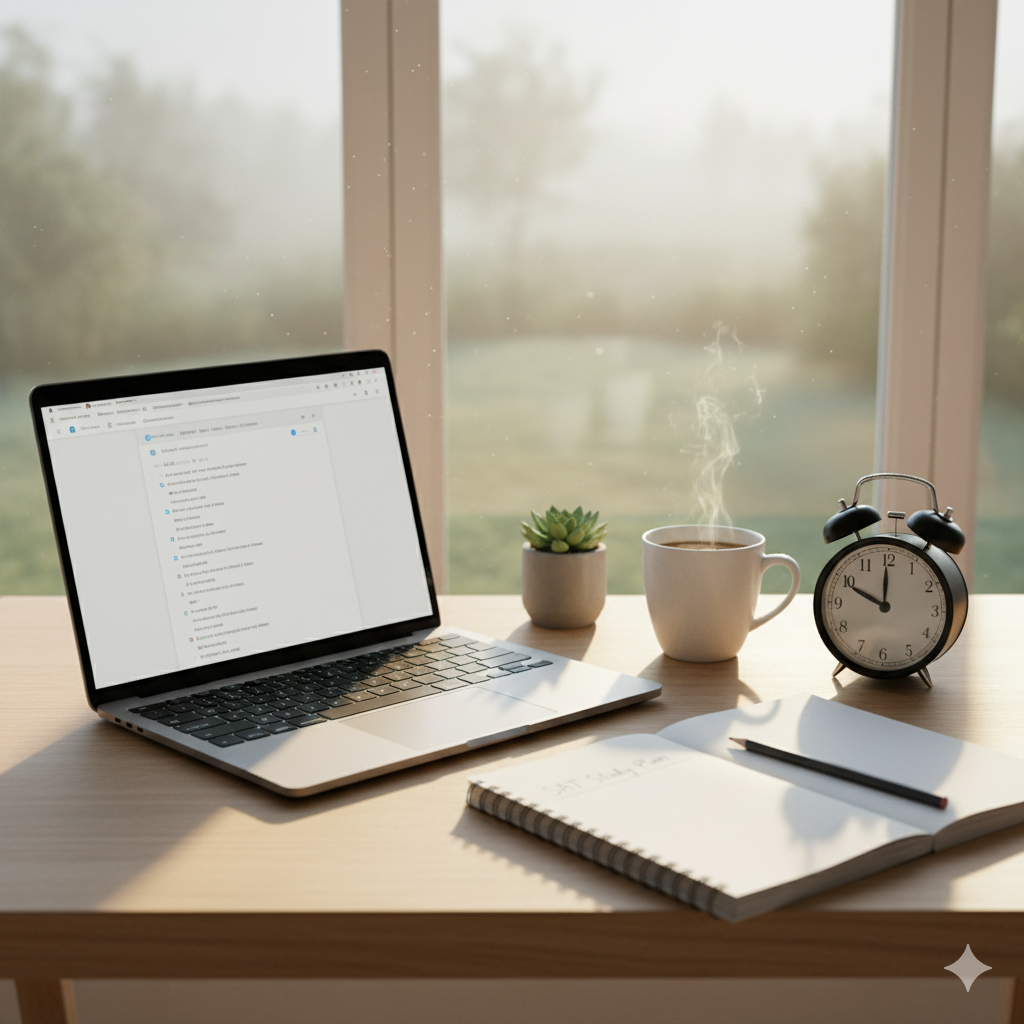Why your chronotype matters — and why mornings can be your advantage
If you wake up with the sun, feel most alert before noon, and do your best thinking with a cup of coffee in hand, congratulations: you’ve been handed a natural edge for SAT prep. The SAT — now in its digital format — rewards focus, clear reasoning, and sustained attention. Morning people often have spikes of mental clarity, energy, and discipline early in the day, which can make study sessions more efficient, learning more durable, and test-simulation closer to a real-test peak performance state.
This blog is a friendly, actionable playbook for students who thrive at dawn. You’ll get routines, study-session templates, realistic sample schedules, quick tactics for each section (Reading, Writing & Language, Math), and test-day tips that respect your biorhythm. You’ll also read about how one-on-one guidance — for example, Sparkl’s personalized tutoring with tailored study plans and AI-driven insights — can fit naturally into a morning-focused strategy to speed progress and reduce stress.
Start with a simple principle: prioritize your best hours
First, map your peak cognitive hours. As a morning person, that’s likely between 6:00 a.m. and noon. The trick is to place the most demanding tasks — full-length practice, hard problem sets, timed reading blocks — in those hours. Easier or restorative tasks (reviewing flashcards, light proofreading, reflection) can live later in the day.
Why? Cognitive science and everyday experience agree: tasks requiring working memory, complex reasoning, and concentration perform best during a person’s high-attention window. For morning larks, that’s early. Respect it. Treating your prime hours like calendar treasure will maximize learning speed and retention.
Build a morning-focused weekly plan
Consistency beats intensity. A steady, distributed practice schedule leverages sleep and morning clarity to build mastery. Here’s a practical weekly template you can adapt to school, activities, and sleep needs.
Sample weekly plan for a morning person (weekday-focused)
Goals: 1–2 intensive morning sessions, lighter evening review, one full practice test on a weekend morning to simulate test day.
- Monday – Friday mornings: 60–90 minutes of focused study (hardest content: Math problem sets, Reading passages).
- Afternoon/evening: 20–30 minutes of light review (vocab, error log, mental math drills).
- Saturday morning: Full Digital SAT practice test (timed, real conditions), followed by a 30–60 minute review session.
- Sunday morning: Targeted skill work (e.g., grammar patterns, algebra review) and planning for the week.
Example weekday morning routine (90 minutes)
- 6:30–6:40 — Wake-up routine (hydrate, 5-minute stretch, light breakfast).
- 6:40–6:45 — 5-minute planning: set intention for this session.
- 6:45–7:30 — Deep study block (timed Reading passage or Math problem set).
- 7:30–7:40 — Immediate review: check answers, note mistakes in your error log.
- 7:40–7:50 — Short synthesis: summarize a strategy or rule you learned.
How to structure a morning study session for the Digital SAT
When mornings are your prime, format sessions so they match attention cycles. Use the following structure for 60–90 minute windows:
- Warm-up (5–10 minutes): quick mental arithmetic, warm-up reading, or a 5-minute grammar quiz.
- Focus block (30–50 minutes): single-target practice—one reading passage, one math section subset, or an uninterrupted set of grammar questions.
- Review and error logging (10–15 minutes): immediate feedback and note-taking.
- Reflection and forward planning (5–10 minutes): write one micro-goal for the next session.
Section-by-section morning strategies
Reading: use your fresh mind for comprehension and inference
Mornings are perfect for deep reading because comprehension and inference rely on working memory and attention. Here’s how to put that early-energy to work:
- Start with active reading: underline or note the passage structure (main idea, tone, shifts in argument).
- Practice timed passages in the morning, then immediately re-read tough sentences aloud to yourself if needed — this helps encode nuanced meaning.
- Build a bank of question stems you trip on (e.g., inference vs. detail vs. function) and practice identifying them at-a-glance.
Writing & Language: fresh eyes prevent careless errors
Grammar, concision, and rhetorical skills often suffer when you’re fatigued. Your morning clarity will reduce careless mistakes. Use short, sharp sets of 15–20 minute editing drills during your prime window. Focus on common SAT patterns: parallelism, verb tense consistency, punctuation for clarity, and sentence brevity. Then close with a 5-minute explanation of why you changed each line — teaching yourself cements rules fast.
Math: tackle hardest problem types early
Whether Algebra, Problem Solving & Data Analysis, or advanced topics, use your morning prime to practice multi-step problems that require planning. Work through problems with the following approach:
- Read the problem once, outline unknowns and relationships.
- Sketch a plan before calculating (this reduces errors).
- Time-box harder problems—spend more minutes early in the morning when you can think through them, and learn to triage during the test.
Sample 4-week morning study plan (overview table)
This table shows a scalable focus for four weeks. Adjust intensity depending on how close you are to test day.
| Week | Morning Focus (Mon–Fri) | Weekend |
|---|---|---|
| Week 1 | Reading strategies & light Math review (60–75 min). | Sat: Diagnostic practice test; Sun: Review mistakes. |
| Week 2 | Target weak math topics + timed reading (75–90 min). | Sat: Section practice test (Math focus); Sun: targeted drills. |
| Week 3 | Writing & Language mastery + mixed practice (75–90 min). | Sat: Full timed practice; Sun: error-log deep dive. |
| Week 4 | Simulate test mornings: shorter warm-ups and one long focus block (90 min). | Sat: Official practice test in morning; Sun: strategic review and rest planning. |
Practical tips to make morning study stick
- Prepare the night before: lay out materials, charge your device, and decide the session’s exact goal. Reduce morning friction.
- Keep a simple ritual: consistent wake-up time, a brisk 5-minute movement, and a small breakfast (protein + carbs) to fuel focus.
- Use light to anchor your body clock: open curtains or study near natural light to strengthen your morning alertness.
- Plan micro-breaks: 5 minutes every 25–30 minutes prevents cognitive fatigue and keeps mornings productive without burnout.
- Use an error log religiously: record every mistake type, why it happened, and a 1-line correction strategy.
How to simulate Digital SAT conditions in the morning
Because the Digital SAT will be administered on devices and timed differently from the paper test, simulate the environment during your weekend morning practices. That means:
- Use a similar device (laptop/tablet) with comparable screen size and keyboard; test navigation speed matters.
- Practice with the same timing and sections in the morning to map peak energy to test segments.
- Work on focus stamina: two consecutive morning practice blocks with only a short break mirrors test endurance requirements.
Test-day morning checklist
Design a calm, confident pre-test ritual to make your morning advantage work on the day that counts. Here’s a checklist to follow about 2–3 hours before the exam:
- Wake up at your usual morning time — avoid drastic schedule shifts.
- Eat a balanced breakfast; include protein to maintain steady energy.
- Do a 5–10 minute light review: skim your error log to prime solutions, not to cram new rules.
- Arrive early enough to set up your device and test environment calmly.
- Use breathing or grounding techniques if you feel jittery; short mindfulness can sharpen focus.
Common pitfalls for morning-focused students — and how to avoid them
- Overtraining in the morning: Doing long, back-to-back three-hour blocks can create diminishing returns. Keep morning sessions targeted and high-quality.
- Neglecting evening review: Mornings build the learning; evenings consolidate it. A short nightly review cements memory.
- Rushing test-day prep: Give yourself time. Habitual morningness can become anxiety if you unfairly compress your pre-test routine.
Small, high-impact practices that fit morning energy
When you have limited time but strong morning focus, these habits return outsized gains:
- Daily 15-minute explanation sessions: teach a friend or record yourself explaining a problem. Explaining clarifies thinking.
- Micro-mock questions: one timed reading passage or five targeted math problems each morning to build momentum.
- Morning reflection: write what you got wrong the previous day and how you’ll fix it today. Tiny corrections compound.

When to add personalized tutoring
Personalized tutoring becomes valuable when progress stalls or when you want a focused, efficient path to score gains. For morning people, one-on-one sessions scheduled in the morning align perfectly with your cognitive peak. A tutor can:
- Design morning-specific lesson plans (e.g., timed-reading circuits at 7 a.m.).
- Provide real-time feedback during your prime hours, accelerating correction of persistent errors.
- Use tools like AI-driven insights to pinpoint weaknesses and create efficient daily micro-tasks.
Sparkl’s personalized tutoring model, for instance, offers tailored study plans, expert tutors, and AI-driven insights that can slot into a morning routine naturally — turning productive mornings into measurable score improvement without overwhelming your schedule.
Examples: two morning routines tailored to different lifestyles
High schooler with early classes
Goal: maintain school performance and prepare for the SAT without over-scheduling.
- 5:45 a.m. — Wake, hydrate, 5-minute stretch.
- 6:00–6:40 a.m. — Focus block: one Reading passage or 6 math problems.
- 6:40–6:50 a.m. — Review and update error log.
- Evening — 15-minute review of flashcards.
Student balancing work and study
Goal: maximize short morning windows for deep learning.
- 6:00 a.m. — Wake, quick breakfast.
- 6:15–7:00 a.m. — High-intensity math practice (triage hardest problems).
- 7:00–7:10 a.m. — Notes and corrective strategy.
- Weekend mornings — longer, full-length practice tests to measure progress.

Tracking progress: easy metrics morning people can use
Pick a small set of metrics and track them weekly. Morning people respond well to data because their sessions are shorter and sharper, so you can measure improvements quickly.
- Timed accuracy: percent correct on morning practice passages/problems.
- Time-to-completion: average minutes per problem or passage.
- Error-type frequency: how often a specific error reappears in your log.
Use a simple spreadsheet or notebook. Each week, compare morning-run metrics to your weekend full-test results to ensure gains generalize beyond your morning peak.
When to shift your strategy
If you notice morning performance improving but test-day afternoons or late-morning blocks are a problem, introduce practice sessions outside your comfort zone. A handful of targeted afternoon sessions can teach flexibility without abandoning your morning-first identity. The goal is: be strong when you’re strongest, and adaptable when needed.
Final pep talk: turn your morning magic into measured advantage
You already have an asset: reliable morning clarity. The SAT rewards sustained attention, sound reasoning, and the ability to think clearly under time constraints — exactly the skills morning people shine at. Treat your prime hours as strategic real estate. Plan focused, high-quality sessions, simulate the test in the morning, keep an error log, and weave in short evening reviews so learning consolidates overnight.
When progress plateaus or you want to accelerate, consider adding personalized tutoring. Tutors who respect your chronotype can build morning-specific study plans, give targeted feedback during your peak hours, and use data-driven insights to slice months off your timeline. Sparkl’s model of 1-on-1 guidance, tailored study plans, expert tutors, and AI-driven feedback fits naturally into this approach by making each morning session smarter and more efficient.
One last concrete tip
For the next seven mornings, commit to a simple experiment: 40 minutes of focused, timed practice, 10 minutes of review, and one sentence in your error log. After a week, compare your accuracy and time-to-completion. Small, consistent changes compound — and with your morning edge, they can compound fast.
Wake up, show up, and let the sunrise be your study partner. With a little structure and thoughtful repetition, your mornings won’t just be pleasant — they’ll be powerful.

















No Comments
Leave a comment Cancel